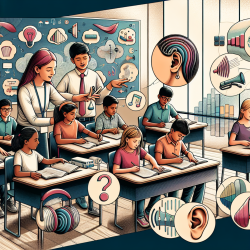Understanding and optimizing the acoustical environment in educational settings is more than a matter of comfort—it's a critical factor in enhancing learning, communication, and overall educational outcomes, particularly for students with hearing impairments. The research conducted by Murray Hodgson, PhD, in "How the Acoustical Environment May Alter Handicap," provides a comprehensive look at the profound impact acoustical environments have on individuals, especially those who are hard of hearing. This blog post aims to translate Hodgson's findings into actionable insights for educators and therapists, encouraging further research and application of these principles to improve educational practices.
The Impact of Acoustical Environments
All human activities, including teaching and learning, occur within an acoustical environment. This environment, defined by its sound characteristics, directly affects people's ability to hear, communicate, and engage with their surroundings. For individuals with normal hearing, a non-optimal acoustical environment can pose challenges; for those who are hard of hearing, these challenges are amplified, potentially leading to increased handicap and social discrimination.
Characteristics of Acoustical Environments
- Energy (Loudness): The volume of sound in an environment can either facilitate or hinder auditory tasks.
- Frequency Content (Pitch): Different activities require the discernment of various sound frequencies, from low to high.
- Temporal Variation: Changes in sound over time, including reverberation, can affect speech perception and auditory scene analysis.
- Direction and Inter-aural Differences: The ability to locate the source of a sound is crucial for navigating environments and understanding speech.
- Signal-to-Noise Ratio: A key factor in the ability to focus on relevant sounds and signals amidst background noise.
Optimizing Educational Environments
The research underscores the necessity of optimizing acoustical environments to accommodate the auditory functions essential for learning and communication. This is particularly crucial in educational settings, where the goal is to support all students, including those with hearing impairments. Here are several strategies educators and therapists can employ:
- Assess and Improve Classroom Acoustics: Conduct regular assessments of classroom acoustics to identify and mitigate sources of noise and echo that can hinder learning.
- Utilize Sound Amplification Systems: In classrooms with poor acoustics or for students with hearing impairments, sound amplification systems can enhance speech intelligibility.
- Consider Classroom Layout: Arrange seating and learning spaces to minimize distance and obstacles between the teacher and students, improving the signal-to-noise ratio.
- Incorporate Visual Aids: Complement auditory information with visual aids to support understanding and retention, especially in suboptimal acoustical environments.
- Engage in Professional Development: Encourage staff to participate in training on the importance of acoustical environments and strategies to optimize them for learning.
Advocating for Acoustical Environment Optimization
Advancing the optimization of acoustical environments in educational settings requires a concerted effort among educators, administrators, and policymakers. By leveraging Hodgson's research, stakeholders can advocate for the necessary resources and changes to ensure that all students, particularly those with hearing impairments, have equitable access to learning opportunities.
Conclusion
The acoustical environment plays a pivotal role in shaping the educational experiences and outcomes for all students. By understanding and applying the insights from Hodgson's research, educators and therapists can create more inclusive, effective, and supportive learning environments. As we strive to meet the diverse needs of our students, let us remember the profound impact that sound and listening conditions have on their ability to learn, communicate, and thrive.
For those interested in delving deeper into the research and its implications for educational practice, I highly encourage reading the original paper by Murray Hodgson. It offers a wealth of knowledge and guidance on creating optimal acoustical environments that can significantly reduce handicap and enhance the educational experience for students with hearing impairments. To read the original research paper, please follow this How the Acoustical Environment May Alter Handicap.










